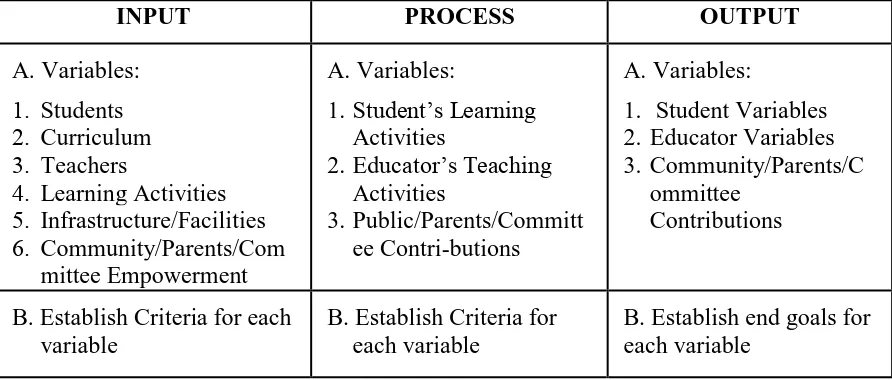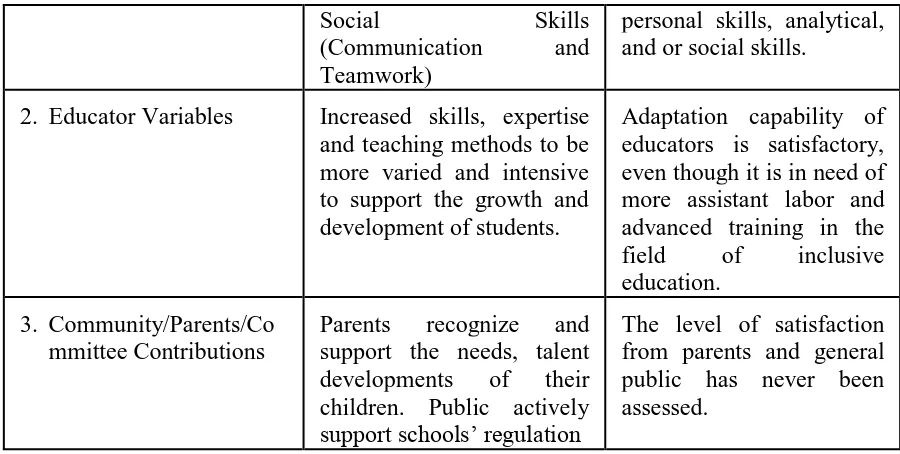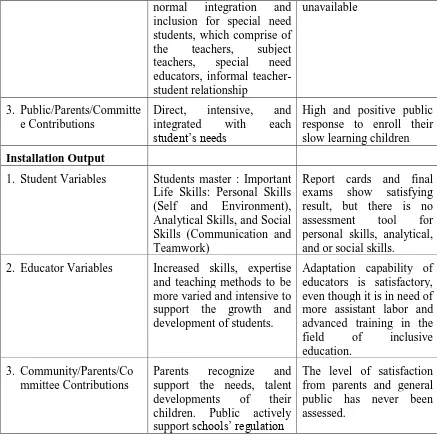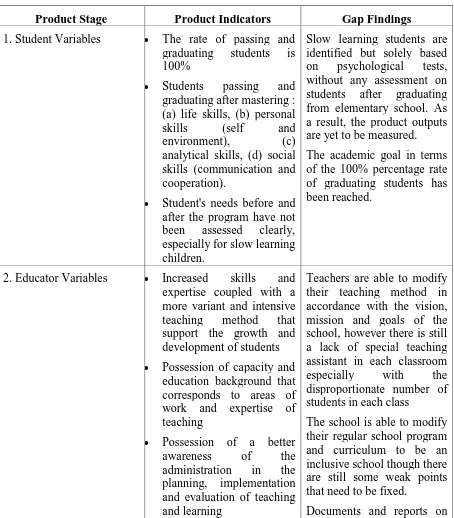Evaluation of Inclusive Education Program for Slow Learners
in SD NegeriPulutan 02 Salatiga
Yanuet Indah Z.T
PPs-Magister ManajemenPendidikan Universitas Kristen Satya Wacana, Salatiga
BambangS.Sulasmono
PPs_MagisterManajemenPendidikan Universitas Kristen Satya Wacana, Salatiga
ABSTRACT
The objective of this study is to evaluate the Inclusive Education Program for Slow Learners in SD NegeriPulutan 02 Salatiga using Discrepancy evaluation model (Malcom Provus). It assesses the gap between the inclusive education program for slow learners in SD NegeriPulutan 02 Salatiga and its standard program. It ha s four stages (design, installation, process, and product). The interviews to the head of school, teachers, students and parents were employed to collect data, and observations in some classrooms were conducted to understand the condition of the slow learner inclusive education implementation in that school. The findings showed that there were gaps in all stages: design (the gap in teacher component, the support of society, measuring instrument for social skills area), installation (the gap in special education needs teacher/SEN teacher, learning process, and the infrastructures), process (the gap in teaching learning activity), product (the gap in students’ social skills and behavior assessment). It was suggested that
SD Pulutan 02 need to create the instrument for assessing students’ achievement in
social and environment skills, create special learning strategy for slow learners, provide the infrastructures for slow learners and create the inclusive planning and implementation program for slow learners.
Keywords : Educational Program Evaluation, Inclusive education, slow learners, discrepancy analysis
INTRODUCTION
Inclusive education is a strategy to promote effective universal education. The
main goal of inclusive education is to educate children with physical, mental, and social
disabilities or often referred to children with special needs in regular classes together with
non-disabled students but with additional support that they need. Previously, children
regular schools. However, it is important for school nowadays to make every effort to
provide inclusion of children with disabilities. (Friend, 2006; Lewis &Doorslag, 2006).
The Salamanca Statement and Framework for Action on Special Needs Education
provides the obligation for schools to accommodate all children, including children who
have physical, intellectual, social, emotional, linguistic or other abnormalities. In
Indonesia, the right to learn is stipulated in Law No. 20 of 2003 on “National Education
System”, Article 5, paragraph 1 to 4. In particular, the Regulation of the Minister of
National Education of Indonesia Number 70 of 2009 Article 1 states that the inclusive
education program is an education system that provides opportunities for all learners with
disabilities, yet with full of potential intelligence and/or special talent, to participate in
learning in an educational environment together with other learners in general. The
implementation of inclusive education aims to provide the widest possible opportunity
and to realize the provision of education that respects diversity of students' abilities and
demonstrates non-discrimination.
Currently, all Inclusive schools in Indonesia from elementary to high school level
accept children with special needs in regular schools but with special treatment. These
students could follow regular classes, but on the other hand they also have to follow
special programs according to their needs and capacity. The curriculum used is the regular curriculum, but with implementation tailored to the students’ ability.
In Salatiga, experiments on inclusive education program have been implemented
since 2010 to six elementary schools and two junior high schoolswith over 115 students
joined the inclusive program. One of the inclusive schools in Salatiga is Elementary
School District of SidorejoSalatigaPulutan 02 (SD NegeriPulutan 02
KecamatanSidorejoSalatiga), which was designated as an inclusive school in Salatiga by
the Decree of the Head of the Department of Education, Youth and Sports No: 420 /
0241.a / 101 on 24 January 2012. The number of pupils in this school is quite a few--with
only 80 students total, but there is at least one child with special educational needs in each class. According to the school’s psychological test report, almost all the special need students in this school have a level of intelligence (IQ) below average. Thus, much of the
Based on the preliminary observations of researchers, there are fundamental issues
in the implementation of inclusive education in SD NegeriPulutan 02
KecamatanSidorejoSalatiga ever since it was established as an inclusive school. The first
issue is that SD NegeriPulutan 02 Salatigahas never held a thorough evaluation of the
inclusive education programs they have run for two years. Evaluation of the current run is
still focused on the results of teaching and student learning activities, but not exhaustive
on the input, process and output of the program. There are various underlying reasons for
not having run a thorough evaluation of inclusive education programs, one of which is
the unavailability of time and instrument evaluation to see the development of the school. The second issue lies on the discrepancy of the school’s adaptability to maximize its resources to achieve the predetermined goal of inclusive education. The main doubt is on
the management of the inclusive program school itself--not so much on the ability of the
learners. As an already “established” school, as opposed to a new inclusive school, SDN
Pulutan 02 develops a tendency to approach their program just like the general primary
school education. This becomes both a strength and weakness of the school that needs
further investigation.
An evaluation was conducted to determine the level of quality of inclusive
education in SDNPulutan 02 in comparison to certain criteria or primary standard.
Researcher applied the evaluation model developed by Malcolm Provus called the
Discrepancy Evaluation Model. This evaluation model is applied because it stresses on
the view that there is a discrepancy in the implementation program--and it assesses the
magnitude of the gap that should be achieved in reality. The gap measured in this
inclusive education program is the gap between the program implemented in reality as
compared to the standard program which has been set as a reference.
Aspects and dimensions of the object to be evaluated are input evaluation, process
evaluation and output evaluation. The targeted object of this evaluation model has 4
stages. First, the design stage is the design of the activities or work program. The focus of
activity at this stage is to formulate the goals, processes or activities, as well as the
allocation of resources to carry out the activities and achieve the goals that have been set.
Second, the installation stage is the provision of tools and equipment needed for the
tools and equipments available for the implementation of the program. Third, namely the
process stage is the process of program implementation. Evaluation at this stage is the
relationship between the resources, tools and equipment to process activities. Fourth, the
product phase is the result of the program. Evaluation at this stage is the final result /
program objectives.
RESEARCH METHODS
This study includes an evaluative study, which analyzed the discrepancy between
the program implementation (or real conditions) with the standard program (point of
reference). This evaluation will be analyzed with the discrepancy model. This
discrepancy evaluation model is performed in 4 phases: the design phase, the installation
phase, the process phase, and the product phase.
The program to be evaluated is the inclusive education program for slow learners
in SD NegeriPulutan 02 Salatiga, with various input, process, and output components, as
well as certain variable criteria.
The source of data used in this study was obtained from the internal data of SD
NegeriPulutan 02 Salatiga, the school where the study was conducted. There are two
kinds of sources: primary and secondary data. The primary source in this research is
directly obtained by interviewing principal, teachers, parents, and the students themselves
regarding the purpose of inclusive education, the planning and implementation of
learning and parental involvement in education programs in school. Meanwhile, the
secondary data includes the Decree of the MInistry of Youth and Sports No
420/0241.a/101 on January 24, 2012, Reports on Psychological Tests in the elementary school, a written report by the school’s principal regarding the Role of the Principal and the Education Curriculum of SD NegeriPulutan 02 Salatiga, as well as the school's own
records on the number of admissions, the schoolteacher's status, and the school
achievements.
Data collection techniques used are document analysis, interviews, and
observations. As for testing the validity and reliability of all data (internal validity) of this
study was done using the credibility test (internal validity) through the extension of the
observation. Extension of the observation means that the researcher returned to the field
DISCUSSION OF RESULTS
The study in SD NegeriPulutan 02 Salatiga is described in three stages, namely
Input, Process, and Output, in six standard references according to the Inclusive
Education Program by Minister of Education (Kemendikbud 2013). These six include:
students, curriculum, teachers, learning activities, infrastructures, and community
empowerments. Meanwhile, the criteria that is used as a comparison or point of reference
is the standard criteria designed by Malcolm Provus (1969) as follows:
Table 1. Design Criteria/Design Standards
B. Establish Criteria for each variable
B. Establish Criteria for each variable
B. Establish end goals for each variable
Source: Malcolm (1969)
The discussion section is analyzed using the gap analysis (discrepancy models) in
four parts, namely: design stage, installation stages, process, and product.
First Stage: Design Stage
Table 2. The Gap of Design Programm
Input Design Indicator Design Gap Findings
1. Students Positive interactions
between non-disabled students and special educational need students
Interactions between non-disabled students and special need students are
3. Educators Accredited relevant
The availability of differentiated classroom teachers, subject teachers and special needs teacher/assistant per classroom
4. Learning Activities Devoted to the student, smaller class size
The approach is quite well
5. Infrastructure/Facilities Public Facilities and Specialized Facilities
Public facilities are met, specialized facilities are still lacking.
There is high support from community/parents/commi Boys/Girls Scout, Physical Education, Art, exemplary coaching, special lesson for special need students
Assessment of learning outcomes is still focused on the achievements of the student's general the teachers, subject teachers, special need educators, informal
Direct, intensive, and integrated with each student’s needs
High public enthusiasm to register their slow learning children.
Output
1. Student Variables Students master: Important Life Skills: Personal Skills (Self and Environment), Analytical Skills, and
Social Skills (Communication and Teamwork)
personal skills, analytical, and or social skills.
2. Educator Variables Increased skills, expertise and teaching methods to be more varied and intensive to support the growth and development of students.
Adaptation capability of educators is satisfactory, even though it is in need of more assistant labor and advanced training in the field of inclusive education.
3. Community/Parents/Co mmittee Contributions
Parents recognize and support the needs, talent developments of their children. Public actively support schools’ regulation
The level of satisfaction from parents and general public has never been assessed.
In the design phase, there is a little gap in the input design and process design,
which is in the educator variables. The reason is because the number of slow learners in
each class is plenty in proportion to the number of special guidance counselor or special
need teachers available, which is only one teacher for the whole school. This number is
inadequate to handle all slow learning students in the school. Meanwhile, for the output
design, for the student variables, the results from their report cards and final exams are
satisfactory. Yet, there is still no assessment tool to measure personal skills
(self/environment), analytical, and social skills. In the educator variables, adaptation by
the educator is also satisfactory, even though there is a lack of guidance and advanced
training in the field of inclusive education. Lastly, there has never been an assessment of
the satisfactory level in the community/parents/committee variables.
Second Stage: Installation Stage
Table 3.The Gap of Installation Programm
Installation Stage Installation Indicators Gap Findings
Installation Input
1. Students Administration for a new concept of admission of new students
Students recognize the concept of inclusive
education
3. Teachers Teachers have relevant
expertise; ideal teachers to students ratio
There is no school policy to specifically educate teachers or to regulate the number of teachers per student
4. Learning Activities Designated learning activities in a small class size
Learning activities have not been drafted in the syllabus, lesson plans, or teaching materials in an orderly manner
5. Infrastructure/Facilities Regulation of public and specialized facilities
Provision of public facilities is still dominant, while specialized facilities procurement policy is still lacking Boys/Girls Scout, Physical Education, Art, exemplary coaching, special lesson for special need students learning students are lacking of students: small class size,
normal integration and inclusion for special need students, which comprise of the teachers, subject teachers, special need educators, informal teacher-student relationship
unavailable
3. Public/Parents/Committe e Contributions
Direct, intensive, and integrated with each student’s needs
High and positive public response to enroll their slow learning children
Installation Output
1. Student Variables Students master : Important Life Skills: Personal Skills (Self and Environment), Analytical Skills, and Social Skills (Communication and Teamwork)
Report cards and final exams show satisfying result, but there is no assessment tool for personal skills, analytical, and or social skills.
2. Educator Variables Increased skills, expertise and teaching methods to be more varied and intensive to support the growth and development of students.
Adaptation capability of educators is satisfactory, even though it is in need of
Parents recognize and support the needs, talent developments of their children. Public actively support schools’ regulation
the student variables, curriculum, teachers, learning activities, infrastructure and
facilities, and community/parents/committees empowerment.
Third Stage: Process
This process stage is to determine whether the behavior of the studied components
change as expected or not. If it does not, it means there is a discrepancy resulting in the
need to amend activities geared toward achieving the behavioral changes.
Process Stage Process Indicators Gap Findings
1. Student Variables General Knowledge,
Counseling Guidance,
learning outcomes is still focused on the activities are still dominant.
Slow learner’s activity is not a priority
2. Educator Variables Methods and materials that focus on the potential, the growth, the needs and interests of students: small classes, normal integration and inclusion for special needs students, which comprise the teachers, subject teachers, special need educators, informal teacher-student
Direct, intensive, and integrated with each student’s needs
achievements of the student's general knowledge. Consequently, the learning activities
still employ the regular/conventional education that do not prioritize the slow learners.
Moreover, there are gaps in the educator side as well, specifically in the teacher to
student ratio that is considered disproportionate. The number of slow learning students
exceeds the proportion each class could support. Simultaneously, the learning activities
has been a positive response in the community/parent variable, in which they support the
implementation of inclusive education in SD NegeriPulutan 02 Salatiga.
Fourth Stage: Product
During the product stage, the assessment is to determine whether or not the final
goal is reached.
Table 5. The Gap of the ProgrammProduct
Product Stage Product Indicators Gap Findings
1. Student Variables The rate of passing and graduating students is 100% skills (communication and cooperation).
Student's needs before and after the program have not been assessed clearly, especially for slow learning children.
Slow learning students are identified but solely based on psychological tests, without any assessment on students after graduating from elementary school. As a result, the product outputs are yet to be measured.
The academic goal in terms of the 100% percentage rate of graduating students has been reached.
2. Educator Variables Increased skills and expertise coupled with a more variant and intensive teaching method that support the growth and development of students
Possession of capacity and education background that corresponds to areas of work and expertise of teaching
Possession of a better awareness of the administration in the planning, implementation school, however there is still a lack of special teaching assistant in each classroom especially with the disproportionate number of students in each class
The school is able to modify their regular school program and curriculum to be an inclusive school though there are still some weak points that need to be fixed.
the vision, mission, and school curriculum have been developed into the concept of inclusive school.
National Curriculum has been integrated into teaching materials of the inclusive education
3.
Community/Parents/Commi ttee Contributions
School committees and communities are involved in school activities planning, implementation and evaluation of school.
The level of satisfaction from public and parents has not been measured.
School committee runs smoothly although their role is still limited in financial management and program planning.
Based on the above table, the gap in the product stage is divided into three
measurement variables, such as the student variables, educator variables, community
variables. For the student variables, academically, the output product is achieved even
though other non-academic assessment such as personal skills has not been measured.
For the educator variables, educator output has increased in terms of skills and ability to
carry out the vision and mission of the school, especially in teaching special need
children. However, there are still gaps in the number of special teaching assistant in every
classroom--especially with the high number of slow learners enrolled in each class.
Consequently, these students are not aided optimally. There is a need for assistance to
handle these slow learners, so that teaching activities can be carried out directly,
intensively, and in accordance to their needs. The same goes for the community
variables/parents/school committees--for public with lower income, the establishment of
this inclusive school is received warmly and greeted enthusiastically because it shelters
their children with special educational needs. Yet, there are still gaps in terms of the
public contribution and its role in accordance with the school inclusive program planning.
CONCLUSIONS AND SUGGESTIONS
The study of inclusive education programs in SD NegeriPulutan 02 Salatiga showed gaps
On the input design and process design, there are gaps in the educator variable
since there is no provision by the school for the amount of educators, specifically
designed to address the slow learners. With only one educator per class, the amount is
inadequate to handle all the slow learning students in the school.In the design of the
output, there is also gap found in the student variables in which there is no measuring tool
to assess personal skills/environment, analytical and or social skills of the students.
Additionally, there are gaps in the educator variables, which are still lacking support for
assistance and advanced training in the field of inclusive education. There are also gaps
in the public/parents/committee variables because their level of satisfaction has not been
measured as well.
On the installationstage, there are gaps in the variables:(1) Educators. The
majority of the teachers still rely on the experience they had on regular/conventional
education program, since there is no qualified and clear teaching guides given by the
school for slow learning students. The number of qualified educators is still lacking with
only one teacher to serve all classes from grade 1 to grade 6. This educator is unable to
perform all of their main tasks as a special need educator.(2) Learning Activities. In the
planning and implementation of learning activities, teachers experience a lack of learning
devices (i.e. syllabus, Lesson Plan/ Teacher’s guidance and other special tools) that are
organized together with other stakeholders, such as educators, psychologists, or
physicians, and parents. Consequently, the learning materials presented to the special
need students are the same as the ones for normal students.(3). Infrastructure/Facilities.
No specialized infrastructure is built for the slow learning students (Resource Room).
On the processstage, there are gaps in the teaching and learning activities,
specifically in the composition of teachers, subject teachers, and classroom teachers.
General school infrastructure still dominates the school, in comparison to a development
of specialized tools for the special need students.In terms of education staff, gaps often
occur in the qualification and suitability of educator's skills with the subject they teach.
This also includes gap on the education and training provided by the school to advance
the quality of the teacher.From other stakeholders' point of view, such as general
public/parents/committee, the program received warm welcome although their level of
On the productstage, despite an increase in the students' graduation rate, which is
100% rate, the assessment for social, environment, and behavior is not known and is not
measured due to a lack of measurement instrument. On the educator's side, no advanced
training and education is available that is based on the needs of teachers. Additionally, to
increase the support from the public, the role of planning, implementation, and evaluation
of school needs to be revised.
Suggestions:
Based on the gap findings in the Inclusive Education Program of slow learners in
SD NegeriPulutan 02 Salatiga, the author conveys some suggestions as follows:
1. For Inclusive Education School Administrator
The result of the study indicate gaps in the design phase, which requires
administrator to create a tool to measure the success of students in the field of personal
skills, such as social, communication, and environment. This can be done by forming a
team that consists of principals, teachers, and parents, as well as experts in accordance
with the school's needs. This area could potentially demonstrate the specialty of inclusive
school in comparison to regular school, which is dominated by solely an academic
assessment.Infrastructure and facilities specialized for special need students (in this case, the slow learners) are needed, specifically the development of a “resource room”. This resource room has a lot of benefits in aiding these students since it demonstrates a focus
on individual assistance. Additionally, both students and special education teachers could
gain trust and concentration in the subject taught--which could potentially provide
therapy for these students.
2. For the School's Principal
The shortage of special assistance teachers could be fulfilled by using job
training’seducators who have educational background in psychology or counseling.
Additionally, they could also use experts from the public or even parents in order to
fulfill the needs for special education teachers in each classroom. School also needs
coaching in developing, planning, and implementing the inclusive education program for
slow learners.
With learning activities still the same for both regular and special need classes,
educators are expected to revise their understanding of the slow learners in order to make
learning strategies that seek to enhance the learning achievements of these students.
REFERENCES
Ainscow, M. 2001.Understanding the DevelopmentofInclusive Schools: Some Notes and Further Reading Paper Available from EENET
Arikunto, S. 2009. Dasar-dasarEvaluasiPendidikan.Jakarta :BumiAksara
Bandi.D. 2006. PembelajaranAnakTunagrahita. Bandung :PTRefikaAditama.
Carlberg, C.&Kavale. K. 1980. The efficacy of special class vs regular class placement for exceptional children: a metaanalysis. TheJournal of Special Education. 14,295-305
Cooter.K.S. & Cooter.R.B.2004.One Size doesn’t Fit All : Slow Learners in Reading
Classroom. International Reading Association (pp.680-684).
Friend, M. 2006. Including Students with Special Needs.Boston: Pearson.
Fernandes,H.J.X.1984. Evaluation of Educational Program. Jakarta: NationalEducationPlanning,Evaluation and Curriculum Development.
Lerner, J.W. 1988. Learning Disabilities: theory,diagnosis and teaching strategies. New Jersey: Houghton Miffin Company
Hallahan, DP &Kauffman,J.M. 1991 dan 1986. Exceptional Children,Introduction to Special Education.Fifth Edition Englewood Cliffs. New Jersey: Prentice Hall Inc.
O’Neil,J.1994. Can inclusion work? A Conversation with James Kauffman and Mara
Sapon-Shevin. Educational Leadership.52 (4)7-11
Provus, Malcolm M. 1969. The Discrepancy Evaluation Model: An Approach to Local Program Improvement and Development. Washington DC: Pittsburg Public School.
Suyanto&Mudjito, 2012. Masa DepanPendidikanInklusif, Jakarta: KementrianPendidikandanKebudayaanDirektoratJenderalPendidikandasar.
Undang-undangNomor 20 tahun 2003 tentangSistemPendidikanNasional



